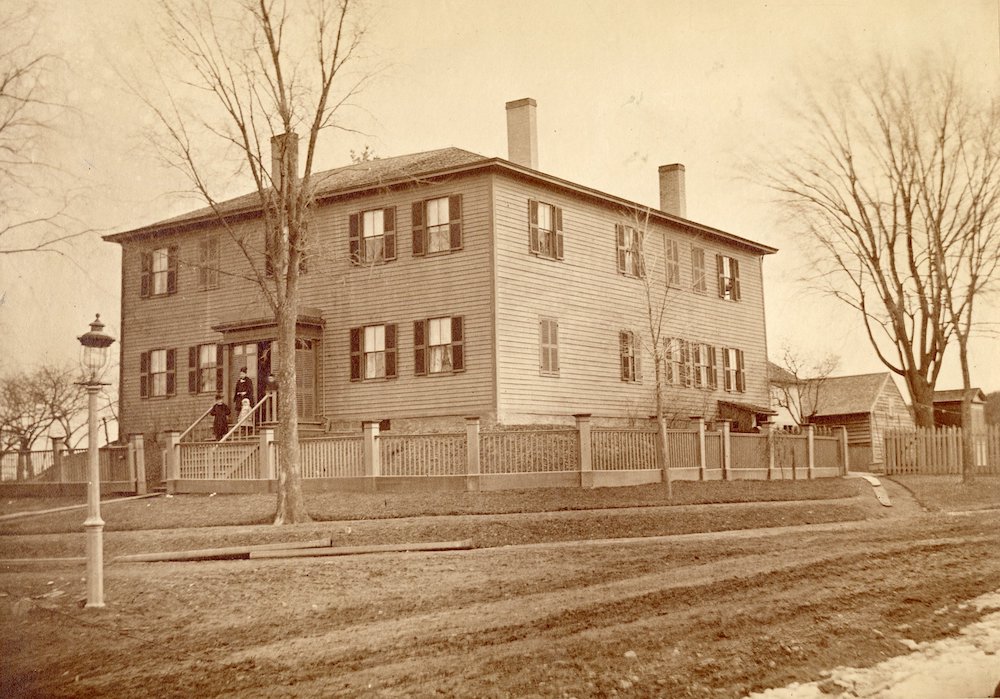We hear a lot about Levi Holbrook in the stories of Danville’s history. He was clearly a colorful character, but, for all that he appears to have been a major an influence on Danville’s historical figures and the institutions they were mutually involved in, not much is concretely known about him.

We do know that Mr. Holbrook was born in 1785 in Holden, Worcester County, Massachusetts to David Holbrook and Judith Bullard Holbrook, and that he was one of possibly fourteen children born to the couple. Levi enrolled in the University of Vermont in 1808 and graduated in 1811 when he moved to Caswell County to take up a teaching position at Hico Academy. Two years later, he received a Master of Arts from University of North Carolina and eventually earned a Doctorate some time later from the same institution.
In 1817, Dr. Holbrook arrived in Danville, having been engaged to head the Danville Male Academy. The Academy was likely originally set up in a log house somewhere downtown near the river but moved into the lower floor of the Masonic Hall when it was located on Craghead street. By 1824 the school was located in a two-story brick building on Grove Street near the cemetery.

It seems Dr. Holbrook made the occasional return home to his roots in Massachusetts, for in 1827 he returned to marry Miss Eliza Gout. The couple had one son, Levi Jr., who was born in Danville in 1836. Three years later, on the 23rd of February 1839, Eliza died of Tuberculosis. Stories differ as to what happened to Levi Jr. and when. Some accounts claim that, following his mother’s death, he was claimed by his maternal grandparents and moved back to Massachusetts. Levi Jr.’s belated death announcement (Virginians learned about it three years after it happened) claimed that Eliza returned to Massachusetts shortly after his birth, leaving her husband and returning to her own family who would help her raise him. (For more on Levi Jr., see Letters to Levi, and More Letters to Levi.)
In 1828, Dr. Holbrook left the Danville Male Academy to establish the Danville Female Academy on the corner of Jefferson Avenue and Loyal Streets (where the Danville General Hospital was located before its demolition). Dr. Holbrook fell ill for a time, and while he was recuperating, his wife ran the school.
Dr. Holbrook’s endeavors in Danville, apart from teaching, included investments in real estate. He owned a house on the corner of Main and Craghead Streets as early as 1829. In 1854, the house burned down. Dr. Holbrook was thus inspired to donate $500 to the city to purchase a fire engine, replacing the bucket brigades.
 Levi Holbrook is of course most famous for selling William T. Sutherlin four acres of land in an oak grove on a hilltop just outside the city limits. Here, Mr. Sutherlin intended to build a mansion. The sale came with the condition that Holbrook should have rooms to live in and to work for the remainder of his life, and he did indeed occupy an office and a small bedroom, with its own entrance, in the west wing of the house until about 1868 when he reportedly had a falling out with Major Sutherlin. The arrangement was by no means one that reflected Holbrook’s own shortage of resources. The 1865 Census identifies him as possessing a personal estate of $281,200 (and several slaves, of which he periodically “rented” to Sutherlin on the condition they be treated humanely, clothed and fed well). From 1868 until his death in 1872, Dr. Holbrook lived in the home of Major Wyllie at 770 Main Street.
Levi Holbrook is of course most famous for selling William T. Sutherlin four acres of land in an oak grove on a hilltop just outside the city limits. Here, Mr. Sutherlin intended to build a mansion. The sale came with the condition that Holbrook should have rooms to live in and to work for the remainder of his life, and he did indeed occupy an office and a small bedroom, with its own entrance, in the west wing of the house until about 1868 when he reportedly had a falling out with Major Sutherlin. The arrangement was by no means one that reflected Holbrook’s own shortage of resources. The 1865 Census identifies him as possessing a personal estate of $281,200 (and several slaves, of which he periodically “rented” to Sutherlin on the condition they be treated humanely, clothed and fed well). From 1868 until his death in 1872, Dr. Holbrook lived in the home of Major Wyllie at 770 Main Street.
Of the many contributions attributed to his good heart and eccentric nature are the digging out of the basement, “with his own hands” of the frame structure that served as the first home of the Episcopal Church. He was also known to have donated $1,000 for the First Presbyterian Church to acquire its first organ. He was among the many of Danville’s citizens known to frequent the Confederate prisons in Danville, and one of the few to be mentioned, and repeatedly, by name for having imparted what he could spare during that time of scarcity and deprivation.
 Dr. Holbrook died on May 20, 1872. He was buried in the old Grove Cemetery, but he was disinterred by his son, Levi, Jr. some time later and removed to the family’s burial site in Massachusetts.
Dr. Holbrook died on May 20, 1872. He was buried in the old Grove Cemetery, but he was disinterred by his son, Levi, Jr. some time later and removed to the family’s burial site in Massachusetts.
Sources:
If Streets Could Talk, Lee Wayland
Victorian Danville, Fifty-two Landmarks: Their Architecture & History, Mary Cahill and Gary Grant
My Father’s Name: A Black Virginia Family after the Civil War, Lawrence P. Jackson
Spared & Shared 3: Letter from Levi Holbrook to his wife.
